
- #Occupancy grid mapping serial#
- #Occupancy grid mapping update#
- #Occupancy grid mapping code#
- #Occupancy grid mapping Pc#
As the robot moves around, the localization program zeros in on the robots location on the prior map. As the robot is moving around, it compares the current map to the prior map and computes the most likely grid location using Markov localization. The analyzer first splits the prior map into a grid and creates a list of SURF features visible to the robot at each grid position. The localization program loads in a prebuilt map and compares the robots current map to the prior map. It then publishes an occupancy grid map of the surroundings.
#Occupancy grid mapping update#
It builds this map by probabilistically modeling each sensor reading as a beam with a gaussian at measurement point and using a Bayes Update rule. The map builder node composes the noisy sensor data and constructs an occupancy grid map. It also subscribes to a geometry_msgs/Twist message on the cmd_vel topic. It publishes a Point cloud of the IR rangers and a odometry topic for the robot's position.
#Occupancy grid mapping serial#
It manages the serial port connection to the robot, parses the communication, and publishes the sensor data to the other nodes.
#Occupancy grid mapping Pc#
The communication node acts as the interface between the robot and the PC program. These first three nodes I programmed myself while the latter two programs are configured components from ROS.

Each of these nodes are separate programs that communicate to each other through ROS topics. It is composed of several different nodes that cooperatively manage the robot: a robot communication node, a map builder, a map localization node, a visualization interface, and a navigation node. The computer program is built using ROS, the Robot Operating System by Willow Garage. It receives the sensor data and directs the robot. Both of these Arduino's communicate wirelessly to a computer over a single Xbee. One board reads the sharp ir rangers and controls the servos while the other board does closed loop motor control for the two faulhaber gear motors that are mounted vertically in the center of the robot. The robot itself uses 2 Arduino Decimillia boards for low level control. To localize itself on its prior map, it uses SURF features of the occupancy grid and a grid based Markov localization technique. For mapping, it uses a probabilistic model beam model of the IR ranger to compose the measurements on an occupancy grid. It can then save the map, be moved around the the environment, and find itself on the previously made map. This allows IRMa to create a very cheap, noisy view of obstacles around the robot.įor my project, I wrote a program to have it autonomously map its environment. The ir-rangers rotate and scan the environment around the robot. It has a sharp ir-ranger mounted on r/c servos at each of its four corners. It was custom designed in Solidworks, CNC milled, and programmed on campus at Rutgers University.


When its not you have to add it to x and y.IRMa, the IR mapping robot, is a small robot, approximately 6" x 6" x 5", that I built for my Principles of Artificial Intelligence course.
#Occupancy grid mapping code#
The code also assumes that your (x,y)-origin is at (0,0). occupancy_grid is here a pointer to a nav_msgs/OccupancyGrid Object. Y = height * occupancy_grid->info.resolution + occupancy_grid->info.resolution / 2 īe careful with is code! I write it out of my memory and its not optimized, with datatypes or even correct. X = width * occupancy_grid->info.resolution + occupancy_grid->info.resolution / 2 So what you need actually to do is iterating over the cells, check if the probability is 100 and if so print the location: for (int width=0 width info.width ++width)įor (int height=0 height info.height ++height) GMapping follows a maximum likelihood convention where a occupancy grid map is a Tri-State: Occupancy probabilities are in the range. The map data, in row-major order, starting with (0,0). So the Occoupancy Grid map is defined here but the most important is: Of course you can assume that the middlepoint of a cell are you coordinates. Actually in occupancy grid maps like in gmapping you dont speak of (x,y) coordinates you are speaking of cells.


 0 kommentar(er)
0 kommentar(er)
